In the quest for ample content, “Best AI Content Detection Tools” emerge as invaluable assets. These tools streamline the process, optimize keywords, and enhance search rankings, ensuring a steady influx of quality visitors.
It might be difficult for many companies to provide enough content. It’s a never-ending procedure that calls for a large staff of independent authors. Additionally, there is a lot of competition for the same phrases, which makes it difficult to rank in search results and draw in quality visitors.
To make problems worse, freelancers may produce articles using AI-powered tools rather than writing them from scratch. Does this strategy affect the ranks of your content? Does AI-assisted material even get picked up by search engines? In this article, we’ll look at how to tell if an article was written by AI and highlight the tools that organisations may use to check that.

AI content detectors are growing in popularity at the same time as new ChatGPT alternatives appear every day. In this article, I’ll discuss 18 of these best AI content detection tools, chatgpt detectors and demonstrate how they rate certain passages from my unpublished, original work in comparison to a few passages on the same subject from ChatGPT. I’ll also go through the kinds of tasks that AI detectors are (and aren’t) well suited for, as well as how marketers, editors, and SEOs should approach them.
The Benefits of AI Content Recognition
With the rapid growth of technology, AI is rapidly becoming more widespread. Additionally, individuals worldwide embrace technology albeit hesitantly and with some curiosity.
Anyone may quickly write in a query for a specific task or inquiry using AI technologies like ChatGPT, which would then provide a finished response that may be to their satisfaction. Artificial intelligence engines like ChatGPT may give you answers or finished tasks based on the prompt you provide, unlike a search engine that displays a list of results.
However, AI detectors might be useful in the following areas: There is a check to see if the AI content was mostly taken from another source thanks to the plagiarism detection features included in many of these systems.
Penalty avoidance: These tools can help you understand how easily visible the AI material is if you’re worried about it being somehow discounted in search results. (Google, of course, will have many tools and inspections.)
Utilising AI audits: These tools can offer a general idea of whether a writer uses AI to produce material if you have a particular policy or method to reward authors for original vs AI-generated work. (Remember that they might provide misleading positives and negatives.)
Understanding search results: A few of these tools include Chrome extensions that can assist you in determining whether or not your rivals’ and other websites’ websites employ AI content.
Functions of AI detection software
Each tool has a distinctive approach to the problem and a different purpose. However, most ChatGPT detection technologies rate the quality of the material by how predictable the word choices are. In other words, whether the identification program considers a piece of writing to be following the likely pattern AI would follow in creating material has a lot to do with whether the content is assessed as AI vs human.
These are the names of the two key ideas behind this procedure:
Burstiness: Sentences that are predictable in length and speed.
Perplexity: The use of words randomly in a phrase or group of sentences.
For instance, it’s quite improbable that generative AI would add a random, poorly written tale about the first time they ever saw a penguin in an essay about the birth of America; hence, that passage would probably appear to be written by a human to a detection tool.
Tools are already being created to get past the detectors, much like ChatGPT detectors, which seemed to identify generative AI writing. Naturally, the detectors are probably already considering how to find the bypassers, etc. Your text will be rewritten by programs like Undetectable or Quillbot, which might sometimes make it harder for AI detection programs to find it. Additionally, several individuals have discovered various prompts that force ChatGPT and other AI writing tools to produce “more human” text than AI. These prompts instruct ChatGPT to write with more confusion and burstiness.
Do you care about detection accuracy?
Before using these technologies in depth, it’s crucial to respond to the following question:
How important is it to you to know whether AI created the material? Then why?
Whether the text “passes” AI writing checks may not matter if you’re using ChatGPT to rewrite title tags or create email copy. Furthermore, if a writer creates a piece of prose using AI and the result is excellent, perhaps the score isn’t even relevant. These AI plagiarism detector tools will probably participate in the aforementioned “detection arms race” with un-detection tools and suggestions.
Comparison of the top AI writing detectors
Suppose you’re still looking for an AI/ChatGPT content detector. In that case, we’ll review each one and how they “scored” when comparing human-generated copy with AI copy and AI copy that intentionally exploited this prompt to “beat detection.”
Note: Testing the detection skills of these programs against a few lines of text isn’t always a complete evaluation. It should offer you a general idea of how people rate various materials and a taste of the variety of results you may anticipate from these sorts of technologies.
(You can see the real samples fed to the programme here, including the “human” sample I wrote, the “AI” sample ChatGPT created using GPT-4, and the updated version based on the same topic.)
The table below shows how each tool evaluated the text I created from scratch, the text I immediately copied from ChatGPT without changing the prompt, and the text I modified to reflect the “perplexity and burstiness” prompt:
A summary of the tools in the table, along with some of their most important characteristics, is given below.
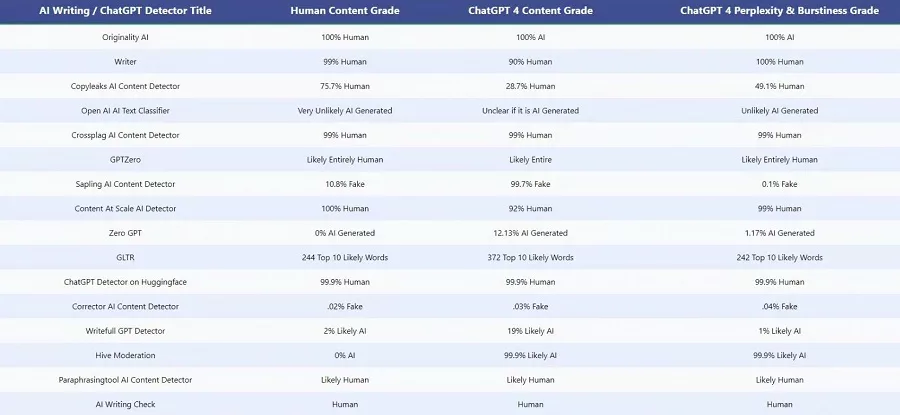
Originality.AI
Originality.AI programme that costs money is called AI and bills itself as “the most accurate AI content detector and plagiarism checker built for serious content publishers.”
Each credit, which scans 100 words, costs $.01. Along with the AI scanner, it has a plagiarism detector. This is the only AI scanner, as shown in the chart above, with a 100% certainty that the human content was human and that the AI content was AI (while also being accurate in every instance). With a 0% AI score for the human material and 99.9% confidence that the two AI-produced texts were written by AI, Hive Moderation (described later in the article) came to essentially the same result.
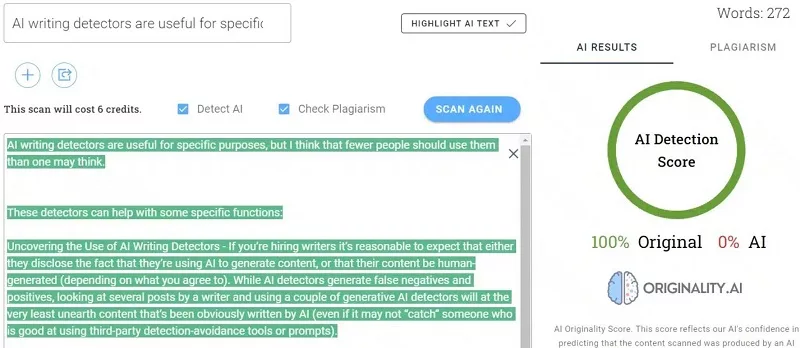
Originality also has a score overall, a Chrome addon, and an Originality.AI feature that highlights the precise parts of the information you paste that it believes will and won’t be AI has been introduced by AI. I use this tool most frequently to look for AI material. The text produced by freelance writers we deal with is checked for AI and plagiarism most frequently.
Writer
Up to 1,500 characters can be detected using the free detector provided by Writer; more characters require API access. In essence, our technology believed that humans probably created all of the contributions.
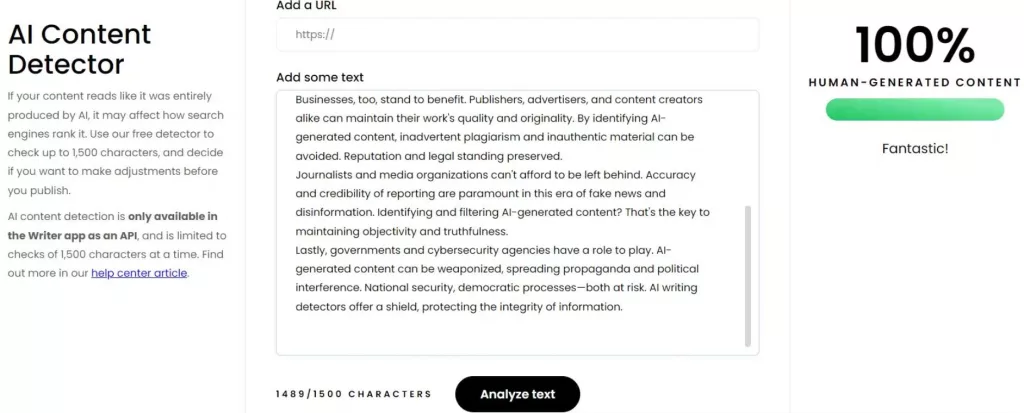
The free content detector on Writer, an AI writing platform, now lets you enter a URL to be checked. This program doesn’t directly check for plagiarism and only provides an overall grade; it doesn’t indicate if AI is probable or unlikely to have created a particular portion.
Copyleaks AI Content Detector
A few intriguing characteristics of the Copyleaks AI Content Detector include:
You get a final judgement (human or artificial intelligence). Hovering your cursor over a text will indicate whether a person or an AI created it.
- It comes pre-loaded with samples of various GPT and human outputs to demonstrate how the tool functions.
- A Chrome add-on exists. Although a single scan cannot perform both tasks, the free program includes a plagiarism checker.
- It correctly classified a large portion of the material produced by humans as human and a large portion of the information produced by AI as AI. It wasn’t always assured, though, and there were a few places when it was inaccurate.

OpenAI’s AI Text Classifier
The startup OpenAI, which also developed ChatGPT and GPT (which powers many generative AI tools), offers a free tool called AI Text Classifier.
The most accurate detector wouldn’t always come from the manufacturer of the most widely used AI tools, at least not in our test.
However, the material from OpenAI’s platform was classified as “unclear” whether it was AI-generated and “unlikely” AI-generated both with and without the extra prompt. The tool classified human content as “very unlikely” to be AI-generated.
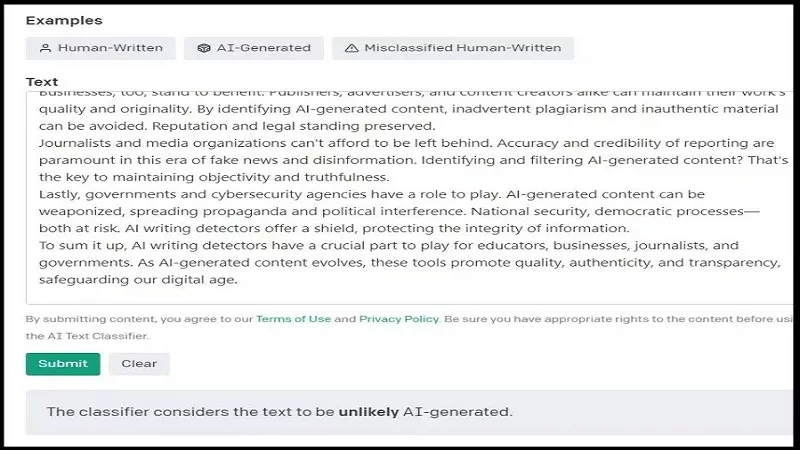
You don’t need to have an OpenAI account to use the tool. There are few bells and whistles, and no plagiarism detection exists. You get a finding (as seen in the screenshot) but no particular score. It also does not flag specific chunks of material based on their likelihood of being AI-generated.
Crossplag AI Content Detector
Without creating an account, Crossplag provides a few free scans. When you log in, you will have access to limitless free scans. The programme provides an overall score but does not allow you to check for plagiarism or mark up specific portions of the article.
Crossplaq determined that the human and AI material was 99.9% human. It is worth mentioning that the tool emphasises that it performs better with lengthier content. Our examples here were more than the minimum of 200 characters but still on the short side.

GPTZero
GPTZero is available in both free and premium editions. The free edition provides you with a score as well as some pre-loaded samples. The commercial edition also includes a plagiarism checker, AI content highlights, and the option to bulk upload several pieces of content (which, like many similar applications, is meant for a classroom context).
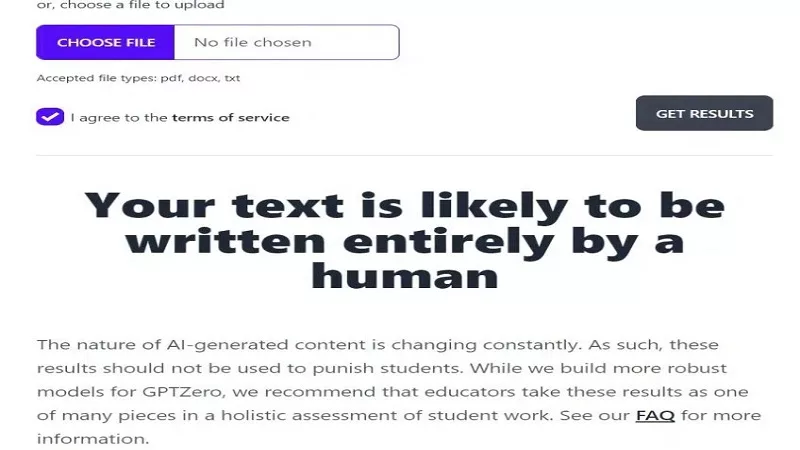
The pricing for the premium tools is not disclosed on the website, but you may request access to the paid tool and the API by filling out forms. The tool’s free version detected all three of our writing samples as being totally human.
Also read – Best ChatGPT Prompts For Beginners
Sapling AI Detector
Sapling AI Detector is available in both free and premium editions, as well as a Chrome Extension, an API, an overall score, and text highlighting.
Sapling determined that the human material was largely human and that the AI component was virtually entirely artificial. On the other hand, the “perplex” and “bursty” ChatGPT material was assessed as very likely to be human.

Content at Scale’s AI Detector
The Content at Scale AI Detector is free and provides a score as well as pre-populated samples and an analysis of key characteristics inside the content (predictability, likelihood, and pattern).
There is no mechanism for detecting plagiarism, and individual text parts are not underlined. All three samples were graded as 92% human or higher by Content at Scale. The most human content was created, followed by prompt-modified GPT material and content generated by the simplest prompt.
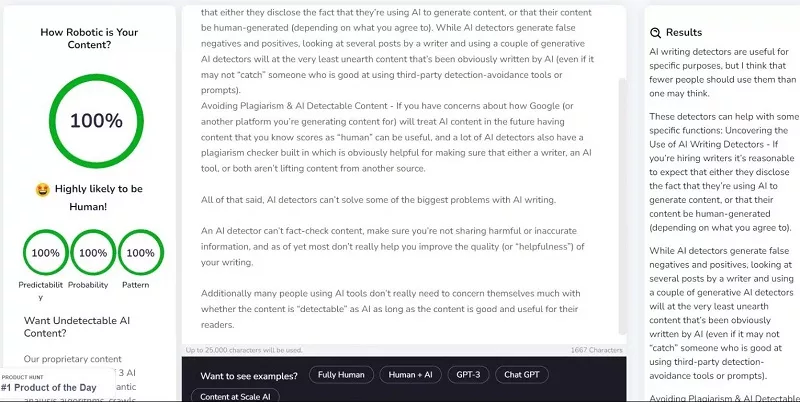
ZeroGPT
ZeroGPT is a free program that provides an overall score and highlighting but does not detect plagiarism.
Across the board, the tool returned low percentages of AI-generated probability. It largely corresponds to the samples’ human-ness, with the human-generated sample receiving the lowest AI percentage, followed by the burstiness/confusion question, and finally by the simpler prompt).
GLTR
The “Giant Language Model Test Room,” or GLTR, is a free tool developed by Hendrik Strobelt, Sebastian Gehrmann, and Alexander Rush of the MIT-IBM Watson AI lab and Harvard NLP.
The tool provides some general grading but mainly reveals if each word in a text was one of the 10, 100, 1,000, or outside the 1,000 most probable words to be created by AI based on the text’s past context. There is no anti-plagiarism function enabled here.
The program returned the most “likely words,” with the most probable words in the top ten for the text created by the simpler query.
Nonetheless, the distribution of the human and extra prompt copies was identical in this tiny test.
ChatGPT Detector on Hugging Face
This is a free detector that provides an overall forecast as well as a score. It has no plagiarism or highlighting features. Our technique gave all three samples a probability of human material greater than 99.9%. Nonetheless, the distribution of the human and extra prompt copies was identical in this tiny test.

Corrector AI Content Detector
Corrector AI Detector is a free tool with a word restriction of 600 and a % score. The programme does not support plagiarism or highlighting. The programme assigned an extremely low % likelihood of each of the samples being “fake” or AI.
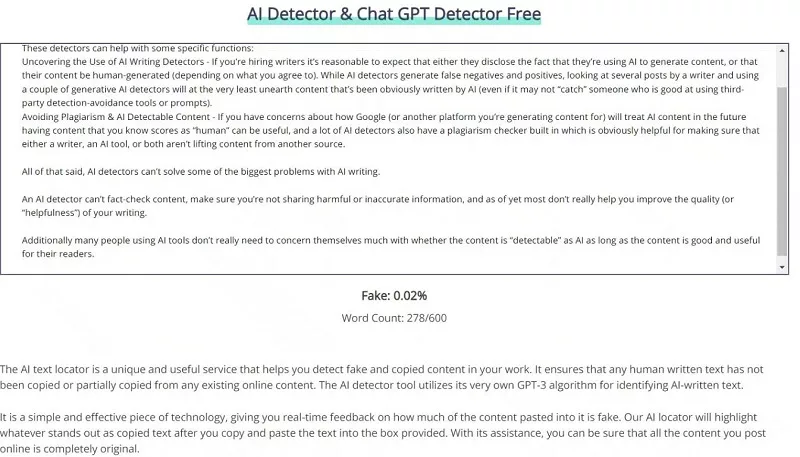
Write full GPT Detector
The Writefull GPT Detector is a free tool that provides a basic score and API access. There is no highlighting or detection of plagiarism.

It determined that all three samples were most likely human, while the ChatGPT content with the shortest query had the greatest AI likelihood (19%).
Hive Moderation’s AI-Generated Content Detection
The Hive Moderation AI-Generated Content Detection tool is free (with character restrictions and a sign-in required after many usage).
It does not support plagiarism or highlighting but lets you divide information into pieces and receive segment-specific rankings. Hive assessed each writing sample correctly, with a 0% possibility of being AI for human material and 99.9% for AI samples. (Only uniqueness.AI had a comparable degree of confidence while being correct across all samples.)
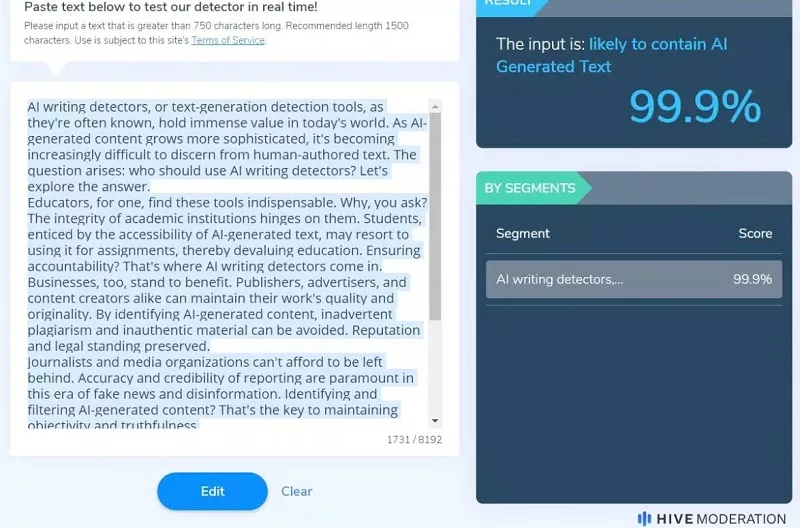
Paraphrasing Tool AI Content Detector
The re-writer is a paraphrasing tool, and they provide this free AI content detector with an overall conclusion, highlighting, and no plagiarism features. The Paraphrasing Tool assessed that humans most likely wrote all of the material.
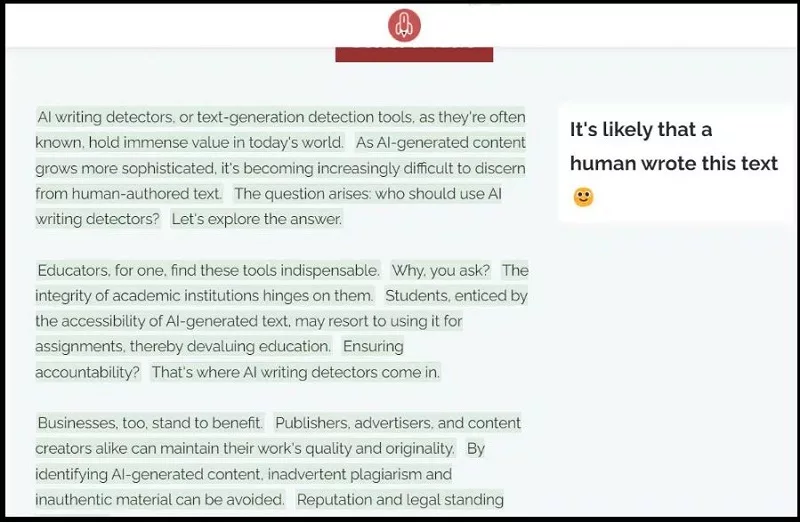
AI Writing Check
AI Writing Check is a free tool with a score, a word limit, and no text highlighting for AI probability or plagiarism features.
All three writing samples were confirmed as human by AI Writing Check.
SEO Kazan
One of the first complete SEO suites to include an AI content recognition technology on its platform is Kazan SEO.
Kazan SEO is a wonderful place to start if you’re searching for a fundamental SEO tool as well as an AI content identification tool.
Keyword clusters, content optimisation, text extraction, AI content generators, and, most significantly, AI content recognition are just a few of the capabilities that this free programme offers.
The usage of AI content identification is free, similar to other platforms, and it swiftly ascertains the total proportion of AI-generated copy in a block of material. It is a smart idea for Kazan SEO to provide the tool because this knowledge is priceless for your whole SEO strategy.
With this tool and Kazan’s other SEO capabilities, you may create an effective, authentic SEO plan that will place you ahead of your competitors.
Corrector App
Authors use the Corrector App to find grammatical problems in their writing. The Corrector App now provides a new AI content identification function and other features.
Users can use this underutilised AI content detection technology for free. A minimum of 300 words must be used in the tool. Even if more suitable apps are available, you could use this one for a fast check.
The Corrector App’s user interface isn’t the greatest on the market. The whole experience appears constrained and the adverts on the page are annoying.
What detecting methods work well (and poorly)
Generative AI and ChatGPT content provide several challenges, as I’ve explained in prior articles:
Information produced by AI has the potential to be factually erroneous, harmful, out-of-date, or deceptive.
The quality of AI writing outputs varies. While there isn’t a specific punishment for AI material, Google may not always trust it and treat it as if a person made it.
AI material has the ability to “fool” editors or companies that believe they are paying for human-created content.
- AI content may take human creative work and repurpose it without giving credit.
- It’s vital to remember that the present AI detectors do not address these issues.
- These technologies usually don’t include citations for material from other sources, fact-check AI content, or enhance or audit content quality.
Before we start, let’s talk about why AI content detection is so important.
How Do Free AI Content Detection Tools Function?
The field of artificial intelligence might be perplexing to many individuals. Since it’s a new technology, everyone works together to learn it as it happens. So, you might be asking yourself, how are these gadgets so intelligent? How can people detect whether a piece of material was produced by artificial intelligence?
To verify whether a person generated the information, AI content detection systems utilise machine learning and natural language processing. A computer system that uses machine learning improves with each query or search it runs. A computer programme that can understand human languages is known as natural language processing.
Additionally, artificial intelligence can quickly assess all the data on the web for a certain subject topic. This enables it to determine if the material is created or authentic.
However, there are plenty of technologies available now that don’t use AI to detect content. Which one is best to use? Let’s look at some of the most well-liked ones on the market right now.
Key findings from 18 AI and ChatGPT content checkers tests
Again, I must qualify my main results since three brief writing examples are insufficient to draw firm judgements regarding the particular tools.
Having said that, I discovered a few intriguing trends in AI writing detectors in general:
Calibration: All three writing samples were deemed to be either extremely probable or highly unlikely to be human by most techniques. When it comes to rating material human vs AI, certain tools will likely be “harder” or “softer” graders, therefore understanding how a tool is calibrated will assist establish how valuable they are.
Rarest elements: Bulk uploads, plagiarism detection, a Chrome extension, and the ability to identify particular areas that are likely to be created by AI as opposed to humans were some of the tools rarest features.
Paid versus free: Every tool included here is either free or paid, with the exception of Originality. A free version of AI existed. However, the tools with the most accurate findings and “rare features” tended to be those having a premium version.
We hope this exploration of “Best AI Content Detection Tools” elevates your content strategy. Thanks for reading, and may your content creation thrive!











